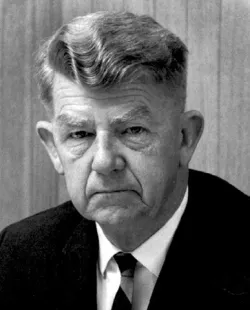Sir Hugh Ennor
Hugh Ennor, an accomplished biochemist and leader in the field, made significant contributions to science and education, holding various prestigious positions and receiving honors such as CBE and Knight Bachelor.

Born in Melbourne in 1912, Hugh Ennor, as he liked to be known, had been a laboratory assistant at the Baker Medical Research Institute in Melbourne in 1929 and after part-time study graduated BSc Hons at the University of Melbourne in 1938. He then worked as a junior NHMRC Research Fellow at the Baker Institute, obtaining an MSc degree in 1939 and being awarded a DSc in 1943. Later that year, at the suggestion of Dr C.H. Kellaway, Director of the Walter and Eliza Hall Institute and Adviser on Medical Topics to the Chemical Defence Board, he joined a research unit set up with collaboration of the British Army to study certain aspects of chemical warfare in the tropics of north Queensland.
In 1944 Kellaway moved to London to become Director of Research at the Wellcome Foundation. Recognizing Ennor's ability as a biochemist, after the war he arranged for the Wellcome Trustees to offer him a two-year fellowship at Oxford, after which he returned to Melbourne as Senior Biochemist at the Commonwealth Serum Laboratories. Wright's advice, which Florey respected, was that in all of the positions which he had occupied, Ennor had shown originality, sound judgement, and a capacity for leadership and organization 'of a most unusually high level,' although his scientific achievements, while considerable, were not epoch making. Ennor was appointed as Professor of Biochemistry in August 1948, and continued to work in laboratories at the Commonwealth Serum Laboratories.
Soon after he moved to Canberra in 1952, Florey, recognizing his leadership qualities, arranged that he should be appointed Dean of the School, initially for two years, to act as chairman of the School Committee and to be the channel of communication between Canberra and Oxford. In February 1967 he accepted the position of permanent secretary to the newly created Department of Education and Science of the Commonwealth Government. He was elected a Fellow of the Australian Academy of Science in 1954 and served as its Treasurer from 1963 to 1967.
During the late 1950s he was active in founding the National Heart Foundation and served as chairman of its National Medical and Scientific Committee from 19601967. In the early 1960s he was responsible for stimulating the interest of three of Australia's leading chemists,then working in Britain, in coming back to Australia to establish a Research School of Chemistry, an initiative approved by Council in 1965. His contributions to science were recognized by honorary degrees from the University of New South Wales (1968) and Monash University (1969). He was created CBE in 1963 and a Knight Bachelor in 1965.
